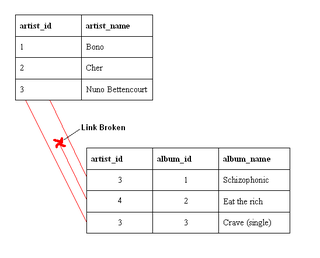Related Research Articles
A relational database (RDB) is a database based on the relational model of data, as proposed by E. F. Codd in 1970.
The relational model (RM) is an approach to managing data using a structure and language consistent with first-order predicate logic, first described in 1969 by English computer scientist Edgar F. Codd, where all data are represented in terms of tuples, grouped into relations. A database organized in terms of the relational model is a relational database.
In computer science, ACID is a set of properties of database transactions intended to guarantee data validity despite errors, power failures, and other mishaps. In the context of databases, a sequence of database operations that satisfies the ACID properties is called a transaction. For example, a transfer of funds from one bank account to another, even involving multiple changes such as debiting one account and crediting another, is a single transaction.
In the relational model of databases, a primary key is a designated attribute (column) that can reliably identify and distinguish between each individual record in a table. The database creator can choose an existing unique attribute or combination of attributes from the table to act as its primary key, or create a new attribute containing a unique ID that exists solely for this purpose.
A foreign key is a set of attributes in a table that refers to the primary key of another table, linking these two tables. In the context of relational databases, a foreign key is subject to an inclusion dependency constraint that the tuples consisting of the foreign key attributes in one relation, R, must also exist in some other relation, S; furthermore that those attributes must also be a candidate key in S.

Referential integrity is a property of data stating that all its references are valid. In the context of relational databases, it requires that if a value of one attribute (column) of a relation (table) references a value of another attribute, then the referenced value must exist.

In the context of SQL, data definition or data description language (DDL) is a syntax for creating and modifying database objects such as tables, indices, and users. DDL statements are similar to a computer programming language for defining data structures, especially database schemas. Common examples of DDL statements include CREATE, ALTER, and DROP. If you see a .ddl file, that means the file contains a statement to create a table. Oracle SQL Developer contains the ability to export from an ERD generated with Data Modeler to either a .sql file or a .ddl file.
A surrogate key in a database is a unique identifier for either an entity in the modeled world or an object in the database. The surrogate key is not derived from application data, unlike a natural key.

A join clause in the Structured Query Language (SQL) combines columns from one or more tables into a new table. The operation corresponds to a join operation in relational algebra. Informally, a join stitches two tables and puts on the same row records with matching fields : INNER, LEFT OUTER, RIGHT OUTER, FULL OUTER and CROSS.
The SQL SELECT statement returns a result set of rows, from one or more tables.
An SQL INSERT statement adds one or more records to any single table in a relational database.
A temporal database stores data relating to time instances. It offers temporal data types and stores information relating to past, present and future time. Temporal databases can be uni-temporal, bi-temporal or tri-temporal.
A database trigger is procedural code that is automatically executed in response to certain events on a particular table or view in a database. The trigger is mostly used for maintaining the integrity of the information on the database. For example, when a new record is added to the employees table, new records should also be created in the tables of the taxes, vacations and salaries. Triggers can also be used to log historical data, for example to keep track of employees' previous salaries.

In SQL, null or NULL is a special marker used to indicate that a data value does not exist in the database. Introduced by the creator of the relational database model, E. F. Codd, SQL null serves to fulfill the requirement that all true relational database management systems (RDBMS) support a representation of "missing information and inapplicable information". Codd also introduced the use of the lowercase Greek omega (ω) symbol to represent null in database theory. In SQL, NULL is a reserved word used to identify this marker.
In data management and data warehousing, a slowly changing dimension (SCD) is a dimension that stores data which, while generally stable, may change over time, often in an unpredictable manner. This contrasts with a rapidly changing dimension, such as transactional parameters like customer ID, product ID, quantity, and price, which undergo frequent updates. Common examples of SCDs include geographical locations, customer details, or product attributes.

Virtuoso Universal Server is a middleware and database engine hybrid that combines the functionality of a traditional relational database management system (RDBMS), object–relational database (ORDBMS), virtual database, RDF, XML, free-text, web application server and file server functionality in a single system. Rather than have dedicated servers for each of the aforementioned functionality realms, Virtuoso is a "universal server"; it enables a single multithreaded server process that implements multiple protocols. The free and open source edition of Virtuoso Universal Server is also known as OpenLink Virtuoso. The software has been developed by OpenLink Software with Kingsley Uyi Idehen and Orri Erling as the chief software architects.
In relational database management systems, a unique key is a candidate key. All the candidate keys of a relation can uniquely identify the records of the relation, but only one of them is used as the primary key of the relation. The remaining candidate keys are called unique keys because they can uniquely identify a record in a relation. Unique keys can consist of multiple columns. Unique keys are also called alternate keys. Unique keys are an alternative to the primary key of the relation. In SQL, the unique keys have a UNIQUE constraint assigned to them in order to prevent duplicates. Alternate keys may be used like the primary key when doing a single-table select or when filtering in a where clause, but are not typically used to join multiple tables.
In relational databases, the log trigger or history trigger is a mechanism for automatic recording of information about changes inserting or/and updating or/and deleting rows in a database table.
SQL:2011 or ISO/IEC 9075:2011 is the seventh revision of the ISO (1987) and ANSI (1986) standard for the SQL database query language. It was formally adopted in December 2011. The standard consists of 9 parts which are described in detail in SQL. The next version is SQL:2016.
The syntax of the SQL programming language is defined and maintained by ISO/IEC SC 32 as part of ISO/IEC 9075. This standard is not freely available. Despite the existence of the standard, SQL code is not completely portable among different database systems without adjustments.
References
- ↑ PostgreSQL 13 Documentation, Chapter 5. Data Definition, Section 5.4.2. Not-Null Constraints, Website: https://www.postgresql.org/docs/13/ddl-constraints.html, Accessed on Jan 9, 2021